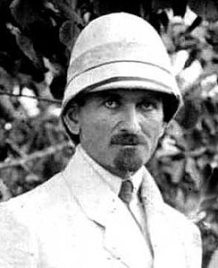Ashkharbek Kalantar
Tuesday, May 13, 2025
Born into the Armenian noble families of Loris-Melikov and Arghutians, he graduated St. Petersburg University in 1911 under Nicholas Marr. He was appointed a Fellow of the Archaeological Institute, of Imperial Russian Archaeological Society and the keeper of the Asiatic Museum in St. Petersburg. He was one of the founders of Yerevan State University. Ashkharbek Kalantar authored more than 80 scholarly articles.
Ashkharbek Kalantar was born in Ardvi (in the modern-day Lori Province of Armenia) on February 11, 1884. He received his early education at the Nersisian School in Tiflis, graduating from there in 1903. He continued his studies at the St. Petersburg University with Nicholas Marr as his teacher. He terminated his studies in 1911 to become a member of the archaeological society of the University.
As a student, Kalantar in 1907 participated the archaeological excavations of Nicholas Marr in the Armenian medieval capital Ani. In 1914 he was appointed the head of the 13th Ani Archaeological excavation campaign.In 1918 he organized the evacuation of about 6000 items from the Ani Museum, which are currently in History Museum of Armenia in Yerevan.[3] He was the last archaeologist to describe monuments, mostly in Ani region, which did not survive after the 1920s.
In 2013 an international expedition repeated Kalantar's expedition of August–September 1920 to document the current - often desperate - situation of ten or more monuments of Ani region (Alaman, Arjo-Arij, Bagaran, Khtskonk, Mren, etc.).
In 1910s Kalantar studied the ancient monuments in the Lori and Surmali regions, the basilica in Zor, headed the excavations in medieval monastery Vanstan (Imirzek) in Armenia and revealed its epigraphic materials. In 1917 with Nicholas Adontz he participated the II Van Archaeological expedition and studied the Urartian inscriptions there.
From 1920 to the 1930s he revealed the existence of a pre-Urartian irrigation system on Mt. Aragats and Geghama range in Armenia, discovered vishaps (stone monuments) there, studied their rock-carved figures, and published articles on the Urartian inscriptions found in Armenia.
In 1918 and 1919 he lectured in Transcaucasian university in Tiflis, in 1919 he becomes one of seven founding members of the Yerevan State University, the founder of the chair of archaeology and oriental studies.
With architect Alexander Tamanian and painter Martiros Saryan he was one of founders of the Commission of Ancient Monuments in Armenia. During 1920-1938 he organized over 30 expeditions in Armenia.
In 1931 Kalantar directed the excavations in Old Vagharshapat.In 1930s with Alexander Tamanian acted to save the two basilica churches, Katoghike and Poghos-Petros in Yerevan (both were finally destroyed by the ruling regime).
In 1935 Kalantar was appointed as the member of the Council of Armenian branch of Soviet Academy of Sciences.





